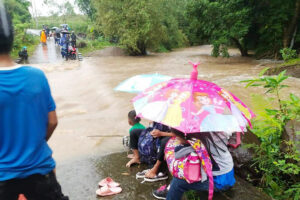CHILDREN from 5.6 million low-income households in the Philippines face deadly threats from the climate crisis, which worsen the state of education in the country, according to a development organization.
“During climate emergencies, many affected families find it hard to send their children to school or even access healthcare,” Save the Children Philippines said in a statement on Sunday.
“Children suffer the most because they look for work to help augment their daily needs,” it said.
As climate shocks significantly affect the livelihood of low-income families, Filipino girls are at greater risk of being “abused, neglected, exploited, or subjected to child marriage,” the organization said.
“No child deserves to grow up in poverty and an unsafe environment. But the reality is grim,” Save the Children Philippines said. “Millions of Filipino children remain poor due to inequality and discrimination, and their situation is exacerbated by the climate.”
According to the 2023 Global Slavery Index of international human rights group Walk Free, climate change worsens modern slavery as it intensifies structural gender inequalities, which mostly affect women, and creates an economic condition that forces parents to give away their children for marriage in order for them to secure some financial stability.
Citing the United Nations, the report said that 80% of those displaced by the climate crisis are female.
“When climate change affects local economies, a larger section of the population loses domestic jobs and engenders internal migration to better-off economic centers,” Hansley A. Juliano, a political economy researcher, told BusinessWorld.
“This promotes congestion in metropolis that also reduces quality of life due to population density,” he added. “This density also feeds exploitative industries who are willing to hold these vulnerable people in low paying jobs, which includes illegal labor and flat-out trafficking.”
The Philippines, considered as an agricultural country, is highly vulnerable to climate change. Last year, Greenpeace told BusinessWorld that as much as 80% of Metro Manila could be submerged by 2030, potentially impacting 87% of its gross domestic product.
Filipino farmers are among the sectors that are heavily affected by the climate crisis, which increases the frequency of extreme El Niño events.
El Niño is expected to derail the growth of the Philippine agriculture sector which, in the first quarter, expanded by 2.1%, a turnaround from the 0.3% decline in the same quarter a year ago.
In 2019, the agriculture sector was severely hit by the weather pattern, with the damage to the sector hitting as much as P8 billion.
Save the Children Philippines urged the Philippine government to craft child-centered climate change mitigation and adaptation plans, noting that many Filipino children lack access to basic services on health, education, proper nutrition, or adequate housing.
“Without urgent and concrete actions to mitigate the negative impact of climate change and support for the most vulnerable families, we are at a setback in fulfilling children’s right to survive, learn, be protected, and thrive,” it said.
President Ferdinand R. Marcos, Jr., who vowed to work towards a shift to green energy, has yet to declare a climate emergency, which would authorize the government to mobilize funds to step up climate mitigation efforts.
The House of Representative made a declaration in 2019, but Greenpeace said last year that a “follow-through” from the National Government has yet to be seen. — Kyle Aristophere T. Atienza
